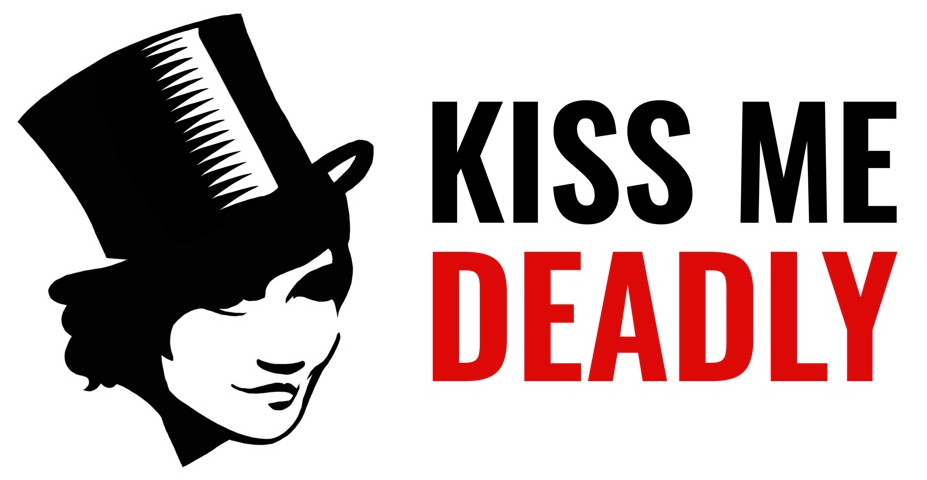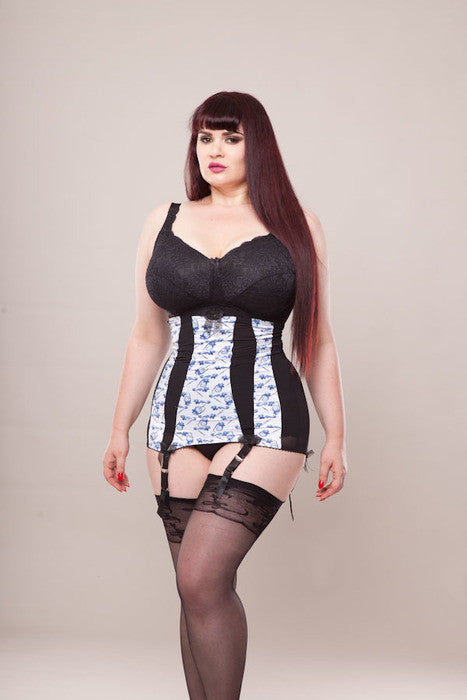Once upon a time, I hated photoshop.
Back when I did my first degree, I did a dissertation on the impact of glossy magazine advertising on people's body esteem. There's a complicated relationship between idealised art and how people feel about themselves. Imagery of people has ALWAYS been 'unrealistic', whether its art or marketing, but back then I thought that Photoshop was the thing that makes the difference between our bodies and a fashion photo so fraught.
These days, I think that while mass media has a sort of mild corrosive effect on the soul, it is unto a mere emery board compared to the hacksaw of serious trauma.
At the time, I failed to recognise a few things;
1) Photoshop techniques are literally photo techniques. They had already existed for decades before we started doing them on computers.
2) The key difference in how we feel is more likely to be to do with the sheer volume of imagery we see rather than the nature of it. It's not like any stage of art was particularly authentic.
3) Wow, a lot goes into the photo before you even get to retouching.
In fact, small brands mostly do everything they can to avoid needing to retouch, so it's that bit I want to share today.
So You Want To Plan A Unretouched Photoshoot? Here's the brief and deadly guide! Including an UNEDITED SHOT! I expect my industry plaudits any minute now ;)

1) Choose a model who is a statistical outlier (i.e. wildly unusual)
Your model could be a catwalk size (UK), a plus/curve size, petite, it doesn't matter. What she absolutely will not be is in any way typical. Even if she is the average size for people that wear your brand, or for people in your country - she absolutely will not be the same shape as them.
Models are genetic oddities. They are chosen to either be very bland and clothes-horsey, or to be extremely distinctive and memorable. It is highly unlikely that you will share a body shape or face with models.
Sod's law, you will carefully spend ages choosing your models, then something will go wrong and you'll end up with someone else on the day - but they'll still be completely not in any way average looking. Though some commercial agency models can be extremely forgettable outside of a photo - like I say, they're chosen to be bland and portray whatever the brand wants.

2) Choose a professional model
Models don't just start out looking different, they also work at it. I have thankfully never had to rely on selling my appearance much to do any of my jobs - from what I've seen, it will just mess with your head. Imagine spending time on exercise and skin care and hair removal and diet and lord know what else, and then you get constantly told you're not what they're looking for.
Experienced models also know how to translate their image from 3D to 2D, how to pose to show things on a flat image, what position looks good, which angle they need the light at to bounce off their cheekbones.
You can also learn this, but be prepared to spend many, many hours in front of the camera doing a sort of stop-motion thing and then checking it all out. I gather many people who grew up with phone cameras ARE doing this - and that's great if it works for you. But feel free to not do it if not actually fun for you. Personally I think it's boring as hell.
Anyways, that shot of a model looking relaxed on a couch probably took 37 uncomfortable tiny contortions to get to. Check out Playful Promises behind the scenes video for an example.
3) Book a location or studio you have carefully chosen
Those of you from the phone camera generation know that backdrops matter. Whether its bold pink walls or fancy wallpaper or this neutral beige tone we used in an attempt to be less scary, you will spend time on this - and it will make things look unreal. None of us float around in a beige void in real life, if only because UK landlords prefer magnolia paint.
 .
.
4) Light it up
From filters to ring lights to weird reflective thingamabobbins, I always expect the "start" of a shoot to be a minimum of 30 minutes of faffing with lights after we actually get there. Anna from Playful Promises has an ongoing obsession with purple filters. Though this was shot on a tiny budget, and is in fact their office floor!
A good light can blur pores, bleach out bruises, glow up your hair and all sorts. Especially in combination with make-up. Speaking of which . . .

5) Spend even more time making up your model and doing their hair.
You know what I love? "Just got out of bed" fashion shoots. Because I KNOW that hair and make-up took TWO HOURS. I know cos I get told off by Morgana all the time for getting bored and talking and then there's lip gloss everywhere and no-one's happy. Models rarely seem to post make-up free shots, so here's my cheery pink face from 2012. For a product shoot, you take someone with already near-immaculate skin and then carefully layer diaphanous veils of primers and potions or sometimes just good old Vaseline, and then you use a whole other set of techniques for hair, and then amazingly the model looks nothing like the rest of us do day-to-day.


6) Style with thought and preparation
Bigger shoots will have a stylist and yes, they really do run around going "Well I thought these gloves with this bolero, but dahling, it's just not working, we need to swap it out for the statement jewellery".
But in all honesty, do you really want a shoot where we show your friend who dressed for a day in the office then collecting their toddler and trying to get them to eat fish fingers without putting them in their ears? Even catalogues for sensible office wear washable at 40 degrees is probably going to leave out authentic toddler snot. Enjoy the fantasy of a clean, bolero wearing paradise, in the full knowledge it is strictly fantasy.
Also for KMD this means packing weapons, which is getting quite tricky.

7) Oh yes, also, ironing
I can't imagine most of you steam your bralettes regularly, but for a shoot, we do. Don't even talk to me about how many steamers we get through (limescale is the devil).
You'll also need a kit of pins, pads, tape and anything else you find handy for making clothes look better on bodies, though that may mean that from the wrong angle your model has a stegosaurus line of bulldog clips down their back. If you've ever seen clothes pinned to mannequins in stores - exactly the same thing happens in shoots, because the chances of your samples perfectly fitting your model are nil.
8) Pose carefully
You'll see people doing a few shots, then putting their heads together to agree what works best, then go back to shooting and checking in. For fashion, it's always more important to get a great shot than to represent reality. Look at this shot, for example;

In reality, Jess, the model in the middle, tops the 6 foot mark. Morgana and Emmie are both considered to be petite models, height-wise (none of them fall within the bounds for agency modelling!)
To get a great shot with all of them in, we muck about with positioning so you have very little idea about scale.
Conversely, on occasion we have exaggerated size differences - portraying Jess as a superhero with Twig as her sidekick, the comic-book effect worked best when positioning them to enhance Jess's height next to Twigs.
This absence of scale can cause a lot of confusion. Deadly Red (the redhead in the Lovebomb banner above) is sometimes assumed to be a plus-size model. In fact, she's petite and full-busted, so she has a lot of curves, but her hip measurements are around a size UK 8-10 - pretty standard for models in the lingerie industry. You can see this slightly better in this new shot from Playful Promises.
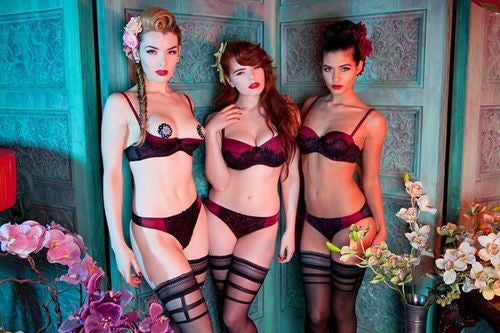
7) Take a MILLION pictures
It's so easy now with digital - you'll just keep snapping till you get a good one. Though time is money, hence why you still prefer working with professional models who have a clue. This is our screens post-shoot:

In my nightmares, thousands of tiny, nigh on identical models pose in faux stop-motion, all demanding to know what's working, whilst I try and check that all the suspenders are aligned and their garments haven't wrinkled.
8) Pick the best
This may involve a fight between you and the photographer, as "artistically" best is different to "shows of the product" best. Still, unlike real life, naff shots do not get uploaded with everything else, you just select one with some care.
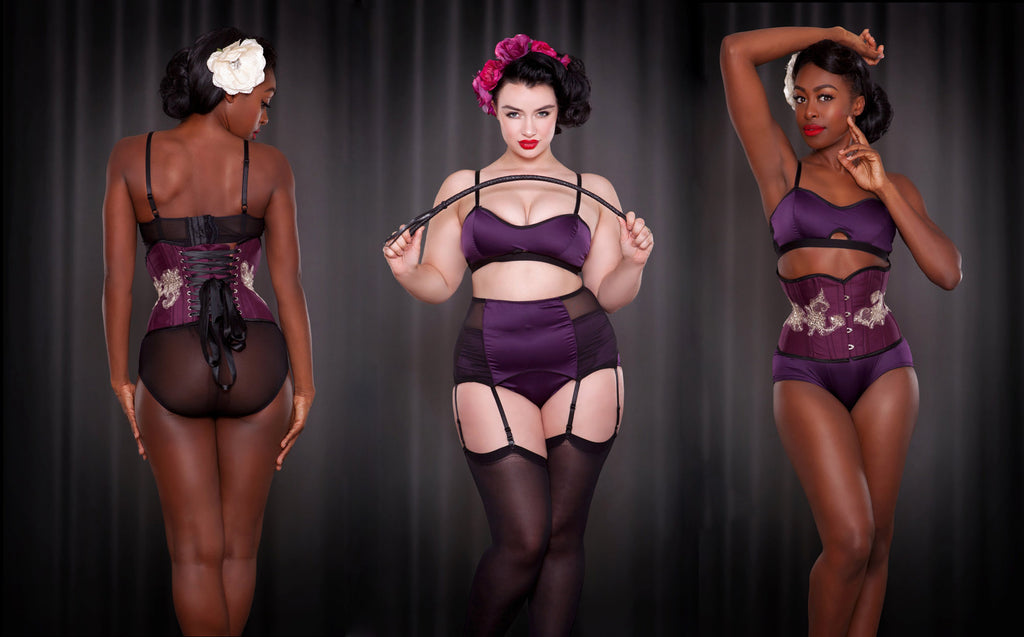
9) Crop it, sort out the tilt, and a few other basics
I'm no editing genius but even I know a good or bad crop of a picture can make a heck of a difference. Back when I wrote this, Instagram was pretty new, but editing it in 2020? I'm pretty certain you ALL know this! I have no idea if this is the democratisation of fashion photography, or just going to drive us all up the wall monitoring our own images. Ask me again in 2030.
10) FINALLY
NOW you hit up photoshop.
Or, if you have someone who is a whizz at it, to the extent that it's cheaper to photoshop in a fancy background than it is to organise one (Hi! Morgana actually spends more time on our curtains than our models!) - THEN, and only then, do you much about in photoshop. Or potatoshop, as it's known in my household, possible due to my level of inability in it.
So here's the big reveal:
I didn't think to ask for a shot of Lexy, our extremely not average but plus-size, full bust model, before the shoot, standing on the street. So here is the professional shot from the professional studio using talented people who both do this for a living, followed by the same shot (probably; I have 3 that are so similar I can't actually tell them apart) after editing.

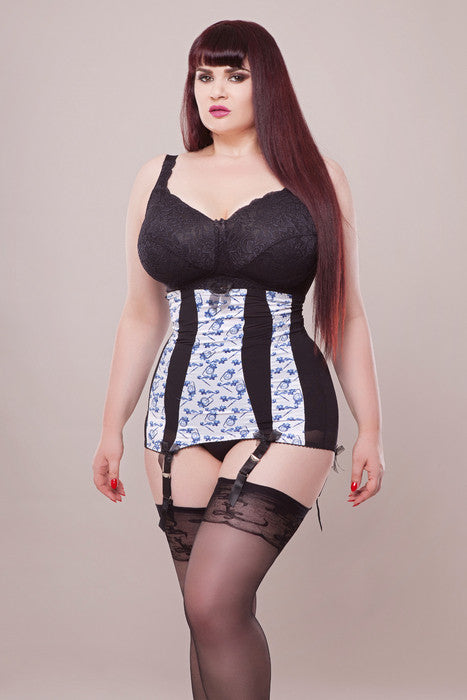
Feel free to disagree with me in the comments, but do you not think most of the work happens pre-edit?!
